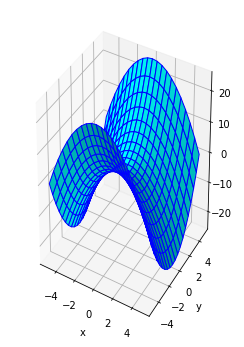Three-Dimensional Coordinate Systems
Since functions of the form z = f(x, y) involve two independent variables x and y, and one dependent variable z, we need a three-dimensional coordinate system for their graphs.
- This is formed by three mutually perpendicular number lines intersecting at their origins.
- Every ordered triplet of numbers (x, y, z) can be associated with a unique point.
- Every unique point can be associated with a triplet of numbers (x, y, z).
Drag the sliders to see the point(x, y, z) plotted in a three-dimensional coordinate system.
Graphs of Functions of Two Variables
In general, the graph of any function of the form z = f(x, y) is called a surface. The graph of such a function is the set of all ordered triplets of numbers (x, y, z) that satisfy the equation.
Drag the sliders to see the graphs of the cross sections of the functions f(x, y) = x2 + y2 and g(x, y) = y2 - x2 holding either x or y constant.
z = f(x, y) = x2 + y2

z = g(x, y) = y2 - x2
